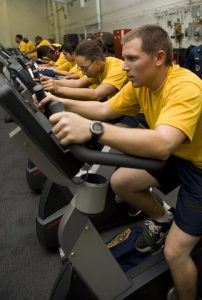In people with chronic pain, the interactions between exercise and pain are complex. On one hand, regular exercise may be one of the most effective treatments because it consistently improves pain, function and quality of life (Geneen et al., 2017). On the other hand, a single session of exercise, such as a brisk 20 min walk, may actually worsen pain (Naugle et al., 2012). The reasons for these different effects of exercise on pain are not clear because the mechanisms of how exercise changes pain are not well understood. Exercise might reduce pain by decreasing the strength of the ‘danger signal’ arriving at the brain, or exercise might change the brain’s interpretation of this danger signal to make it less threatening (or, likely, some combination of both).
Pain expectations are an important part of an individual’s pain experience. For example, imagery or verbal suggestion can increase or decrease pain depending on the type of expectation provided (Peerderman et al., 2016). In our study, we examined the cognitive contribution to pain (Jones et al., 2017). We tested if we could change a person’s expectations about how exercise might influence their pain and whether this subsequently influenced their pain responses after exercise. We did this by measuring pain thresholds before and after exercise in two groups of pain-free adults: 1) a group who was not conditioned to expect any change in their pain after exercise and 2) a group who was conditioned to expect a reduction in their pain after exercise. We used education about exercise-induced hypoalgesia (i.e. the short-term reduction in pain that occurs after exercise) to condition participants in the second group to expect a reduction in their pain after exercise.
WHAT DID WE FIND?
We found that 20 minutes of moderate-high intensity cycling increased pain thresholds (i.e. less pain) in both groups. However, the increase in pain threshold following exercise was greater in the group who had been conditioned to expect a reduction in their pain after exercise (+13%) compared to the group who had not (+3%).
SIGNIFICANCE AND IMPLICATIONS
The results from our study demonstrate a direct influence of cognitive factors on exercise-induced hypoalgesia in pain-free adults. If this finding can be replicated in people with chronic pain, it could have potential clinical implications for exercise prescription. For example, patients who normally avoid exercise for fear of it worsening their symptoms could be conditioned to expect a reduction in their pain after exercise. This may reduce their pain from a single bout of exercise, making them less fearful of exercise and more likely to adhere to exercise in the long term.
PUBLICATION REFERENCE
Jones MD, Valenzuela T, Booth J, Taylor JL, Barry BK. Explicit education about exercise-induced hypoalgesia influences pain responses to acute exercise in healthy adults: A randomized controlled trial. J Pain 18: 1409-1416, 2017.
If you cannot access the paper, please click here to request a copy.
KEY REFERENCES
Geneen LJ, Moore RA, Clarke C, Martin D, Colvin LA, Smith BH. Physical activity and exercise for chronic pain in adults: an overview of Cochrane Reviews. Cochrane Database Syst Rev CD011279. 2017.
Naugle KM, Fillingim RB, Riley JL 3rd. A meta-analytic review of the hypoalgesic effects of exercise. J Pain 13:1139-1150. 2012.
Peerderman KJ, van Laarhoven AI, Keij SM, Vase L, Rovers MM, Peters ML, Evers AW. Relieving patients’ pain with expectation interventions: a meta-analysis. Pain 157: 1179-1191. 2016.
AUTHOR BIO
 Matthew Jones is an Accredited Exercise Physiologist. He works as an Associate Lecturer in the Department of Exercise Physiology at the University of New South Wales and as a Postdoctoral Fellow at the Kirby Institute. His research investigates the mechanisms through which exercise influences pain. You can read Matthew’s other blogs on pain and exercise here.
Matthew Jones is an Accredited Exercise Physiologist. He works as an Associate Lecturer in the Department of Exercise Physiology at the University of New South Wales and as a Postdoctoral Fellow at the Kirby Institute. His research investigates the mechanisms through which exercise influences pain. You can read Matthew’s other blogs on pain and exercise here.

